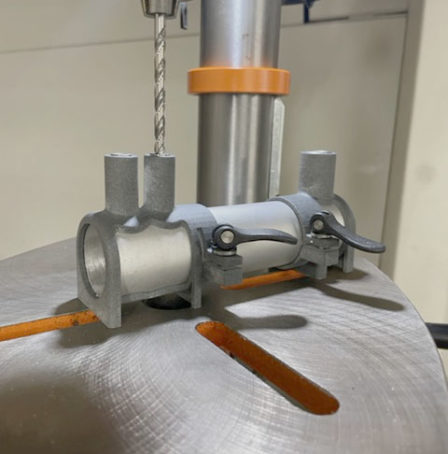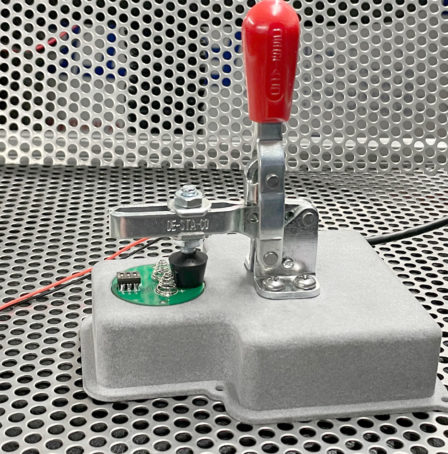3D PRINTING ELEVATES THE PRODUCTION OF MANUFACTURING AIDS.
In the age of lean manufacturing and agile production, companies are looking for ways to maximize productivity while keeping costs at a minimum. To improve the efficiency and quality of manufacturing operations, companies often rely on jigs, fixtures, and other manufacturing aids. While traditional production techniques can make the fabrication of manufacturing aids a long and costly process, 3D printing – also known as additive manufacturing (AM) – can make these tools a reality faster and more affordably.
Manufacturing aids range from simple tools, like a ruler or calibrator, to complex jigs and holding fixtures. Effective manufacturing aids increase the efficiency and repeatability of production, resulting in higher quality products and lower costs. These productivity tools are a necessity to maintain accurate, repeatable, and interchangeable manufacturing operations.
In general, manufacturing aids offer the following benefits:
-
- Quality: Defects are quickly detected with gauges or pass/fail systems.
- Repeatability: Uniform production with correct part placement.
- Productivity: Streamlining production; reducing the amount of steps needed for assembly.
- Skill Reduction: Ensures proper alignment of the tool with the part; eliminating the need for skilled machine operators.
- Decreased Costs: The result of increased productivity combined with a decrease in unsatisfactory parts and the need for skilled labor.
BREAKING CONVENTION WITH 3D PRINTING
Although simple jigs and fixtures are available off-the-shelf, manufacturers often need production tools unique to their operations and products. The most common method to produce custom manufacturing aids is CNC machining using steel, aluminum or plastic. Other conventional technologies include injection molding and extrusion. These subtractive manufacturing methods usually entail long lead times, high production costs, and little flexibility for design iteration.
With 3D printing, jigs and fixtures can be customized to the product and manufacturing operation faster and at lower costs compared to conventional production methods. 3D printing offers several key advantages that improve jigs and fixtures production:
Faster Lead Times
A key advantage of 3D printing is speed. Unlike machining or other conventional production methods, which can take weeks (or months if outsourced) and may require intensive planning, 3D printing is an automated digital manufacturing process. This means parts will not need hard tooling; all that is needed to start production is a 3D CAD model. The absence of hard tooling makes it ideal for one-off parts like custom manufacturing aids.
The speed in which jigs and fixtures can be produced with 3D printing means that it is also ideal for multiple iterations. With HP Multi Jet Fusion (MJF) 3D Printing, varying design iterations can be manufactured in a single production run – providing the flexibility to incorporate design changes and test modifications quickly.
Freedom of Design
3D printing can produce geometrically complex parts which traditional manufacturing methods are not always able to produce. Liberated from the restraints of conventional manufacturing, 3D printing is capable of producing complex parts and intricate geometries- opening nearly endless opportunities for manufacturing aid configuration without the cost of hard tooling.
Component Consolidation
Thanks to design freedom, 3D printing also allows for component consolidation. Manufacturing tools engineered with multiple components requiring assembly and fits, can be designed as one part, reducing the costs and long lead times associated with assembly operations.
Improved Ergonomics
Considering jigs and fixtures are physically handled by workers on the production floor, lightweight and easily accessible tools are a priority for manufacturers. Conventionally manufactured tools fabricated with design restraints can be heavy and bulky, adding strain to workers and time on the production line. Jigs and fixtures lacking basic ergonomic functionality can have a huge impact on quality and efficiency, such as an increased number of defects, significant down time on the production floor, and worker discomfort.
The freedom of design and consolidation in 3D printing allow for lighter manufacturing aids with improved handling. 3D printed manufacturing aids are an effective way to incorporate contours and organic shapes that increase worker safety, efficacy, and comfort. Additionally, high-performance polymer 3D printing materials can create strong, lightweight manufacturing aids with enhanced mechanical properties.
Streamlining Fabrication
3D printing advances the performance of jigs and fixtures by being a more efficient way to move new and improved designs into production. The accessibility of a digital file means manufacturing aids can be produced in lower quantities or as needed. This “digital inventory” is always available and manufacturing aids can be updated and redesigned quickly and effortlessly. Moreover, 3D printing provides the ability to personalize manufacturing aids and parts with serial numbers, fabrication dates, and other key inventory and production data.
Cost Savings
Ultimately, all the above benefits result in a reduction in costs compared to fabricating custom manufacturing aids using conventional methods. 3D printing custom manufacturing aids offers faster lead times, complexity, and customization to increase productivity and decrease operating costs.
3D Printed Manufacturing Aids in Action
Many manufacturers, including Avid Product Development, are utilizing the economic and productivity benefits of 3D printing for production tools. Here are examples of how we use our MJF 3D printing capabilities for customer manufacturing projects:



Maximizing Productivity
Manufacturing aids are the backbone of production. Whether it’s jigs, fixtures or grips, production tools are a vital part of manufacturing. Regardless of product and operational complexity, productivity and efficiency of production depend on the availability of quality manufacturing aids.
3D printed jigs, fixtures, and other manufacturing aids help maximize productivity and improve the quality of operations in the fraction of the time and cost of conventional fabrication processes. As lean manufacturing and agile production becomes more paramount, companies utilizing 3D printing will realize improvements in both efficiency and quality within their production and assembly lines.
Start streamlining your production today with a 3D Printing Quote.
